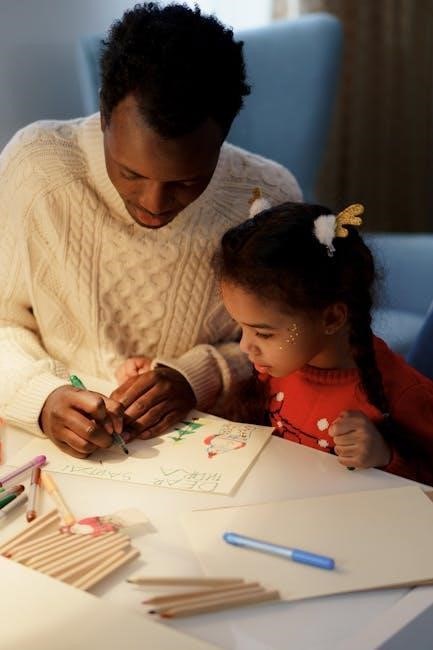Adinkra symbols are visual representations rooted in Akan wisdom‚ created by Kwadwo Adinkra. They convey messages about life‚ wisdom‚ and cultural values‚ symbolizing heritage and philosophy.
Origin and Historical Background
The Adinkra symbols originated in West Africa‚ specifically among the Akan people‚ and are attributed to Kwadwo Adinkra‚ a king of the Gyaman state. These symbols were traditionally used in cloth printing‚ conveying messages about life‚ wisdom‚ and cultural values. The name “Adinkra” translates to “farewell” or “goodbye” in the Twi language‚ reflecting their historical use in ceremonies and storytelling. The symbols were initially reserved for royalty but later became accessible to the broader population. Each symbol is deeply rooted in Akan philosophy‚ representing proverbs‚ historical events‚ and moral lessons. Created using natural materials like bark and leaves‚ Adinkra designs have evolved over centuries‚ preserving the heritage and wisdom of the Akan people while inspiring modern applications worldwide.
Adinkra Symbols in West African Culture
Adinkra symbols hold a significant place in West African culture‚ particularly among the Akan people of Ghana. They are deeply embedded in the cultural fabric‚ serving as visual representations of proverbs‚ moral lessons‚ and historical events. These symbols are often used in Kente cloth and other textiles‚ which are worn during ceremonies and special occasions. In West African societies‚ Adinkra symbols are not only decorative but also carry profound meanings that reflect community values and wisdom. They are used to communicate messages about life‚ courage‚ and wisdom‚ making them an integral part of cultural identity. The symbols are also used in various social and religious contexts‚ further highlighting their importance in preserving and transmitting cultural heritage across generations.
Significance of Adinkra Symbols in Akan Tradition
In Akan tradition‚ Adinkra symbols are revered for their deep philosophical and spiritual significance. They encapsulate the wisdom‚ values‚ and history of the Akan people‚ serving as a bridge between the past and present. These symbols are integral to cultural practices‚ including rites of passage‚ storytelling‚ and moral education. They convey essential life lessons about courage‚ wisdom‚ and community‚ reinforcing the Akan ethos of collective responsibility and moral integrity. The symbols are also used in leadership and decision-making processes‚ symbolizing strength and guidance. Their presence in art‚ textiles‚ and daily life underscores their role in preserving Akan identity and heritage‚ ensuring that future generations continue to draw inspiration from their timeless wisdom. Thus‚ Adinkra symbols remain a cornerstone of Akan cultural and spiritual traditions‚ embodying the essence of their rich legacy.

Meaning and Symbolism of Adinkra Symbols
Adinkra symbols carry deep meaning‚ reflecting Akan philosophy‚ wisdom‚ and cultural values. Each symbol represents themes like courage‚ wisdom‚ and community‚ serving as visual proverbs in Akan tradition.
Key Themes and Philosophical Concepts
Adinkra symbols encapsulate essential Akan philosophical concepts‚ emphasizing themes such as wisdom‚ courage‚ and community. They reflect values like patience‚ tolerance‚ and leadership‚ drawn from proverbs and cultural traditions. These symbols also explore existential ideas‚ such as the transient nature of life and the importance of moral behavior. The use of proverbs within the symbols highlights the Akan belief in the power of wisdom and the importance of passing knowledge through generations. Each symbol serves as a visual representation of these philosophical ideals‚ making them a cornerstone of Akan cultural and intellectual heritage. Through their intricate designs‚ Adinkra symbols continue to inspire reflection and guide individuals in their daily lives.
Symbolic Meanings and Interpretations
Adinkra symbols are rich in symbolic meanings‚ often derived from proverbs and Akan cultural wisdom. Each symbol represents a unique concept‚ such as wisdom‚ patience‚ or courage‚ visually encoded for easy understanding. For instance‚ the AKOBEN symbol‚ shaped like a war horn‚ signifies vigilance and preparedness‚ while AKOMA‚ resembling a heart‚ embodies patience and tolerance. These symbols are deeply rooted in Akan philosophy‚ offering insights into moral values and existential truths. Their interpretations are versatile‚ allowing individuals to apply their meanings to various aspects of life. By studying these symbols‚ one gains a profound understanding of Akan heritage and its emphasis on wisdom‚ community‚ and moral guidance. Their timeless relevance continues to inspire reflection and cultural connection today.
Use of Proverbs in Adinkra Symbolism
Adinkra symbols are deeply intertwined with Akan proverbs‚ serving as visual representations of wise sayings and moral lessons. Each symbol encapsulates a proverbial message‚ reflecting the Akan people’s emphasis on wisdom‚ community‚ and ethical behavior. For instance‚ the AKOBEN symbol‚ shaped like a war horn‚ is linked to the proverbial idea of vigilance and preparedness in life. Similarly‚ AKOMA‚ symbolizing patience and tolerance‚ is rooted in proverbs that highlight the importance of endurance. These symbols act as reminders of cultural values‚ offering guidance and fostering critical thinking. By integrating proverbs into their design‚ Adinkra symbols become powerful tools for teaching and preserving Akan philosophy‚ ensuring their relevance across generations.

Popular Adinkra Symbols and Their Meanings
ADINKRAHENE represents leadership‚ AKOBEN symbolizes vigilance‚ and AKOMA embodies patience‚ each carrying deep cultural and philosophical significance in Akan tradition and West African heritage.
ADINKRAHENE: The Chief of Adinkra Symbols
ADINKRAHENE‚ meaning “chief of Adinkra symbols‚” is a prominent symbol representing greatness‚ charisma‚ and leadership. It embodies the pinnacle of wisdom and authority‚ often associated with kingship and esteemed qualities. Historically‚ it signifies the highest rank in Adinkra symbolism‚ reflecting the values of the Akan people. This symbol is deeply revered‚ often used to honor leaders and individuals of exceptional character. Its design and philosophical weight make it a central icon in West African cultural heritage‚ symbolizing the ideals of leadership and community guidance. ADINKRAHENE is not just a symbol but a representation of the collective aspirations and values of the Akan tradition‚ emphasizing the importance of strong‚ wise leadership in society.
AKOBEN: Symbol of Vigilance and Wariness
AKOBEN‚ translating to “war horn‚” is an Adinkra symbol representing vigilance‚ wariness‚ and preparedness. It signifies the importance of being alert and cautious in life’s challenges. Historically‚ it reflects the Akan people’s readiness for defense and their strategic approach to warfare. The symbol is often associated with the call to action‚ reminding individuals to remain vigilant and proactive in safeguarding their communities and interests. AKOBEN also embodies the wisdom of anticipating potential dangers and taking preventive measures. Its presence in art and culture serves as a reminder to stay informed and responsive‚ ensuring safety and prosperity. This symbol underscores the Akan philosophy of prudence and the necessity of maintaining awareness in an ever-changing world.
AKOMA: Representation of Patience and Tolerance
AKOMA‚ symbolizing the heart‚ embodies patience and tolerance in Akan culture. It reflects the virtue of enduring life’s challenges gracefully‚ emphasizing the importance of calmness and composure. The heart‚ as a symbol‚ signifies emotional resilience and the ability to withstand difficulties without losing balance. AKOMA teaches the value of introspection and self-control‚ encouraging individuals to approach situations with wisdom and empathy. In Akan philosophy‚ patience is seen as a strength‚ allowing one to navigate life’s complexities with dignity. This symbol is often used in art and textiles to remind people of the power of tolerance and the need to maintain harmony in relationships. AKOMA serves as a timeless lesson in the importance of emotional intelligence and serene perseverance.

Cultural and Modern Applications
Adinkra symbols are traditionally used in Kente cloth and textiles‚ while modern applications include art‚ fashion‚ and branding‚ preserving their cultural significance in contemporary contexts today.

Adinkra Symbols in Kente Cloth and Textiles
Adinkra symbols are deeply integrated into Kente cloth‚ a traditional textile of the Akan people. Each symbol‚ printed using a calabash stamp‚ carries philosophical meanings tied to proverbs‚ wisdom‚ and cultural values. Kente cloth is woven with vibrant colors‚ and the inclusion of Adinkra symbols adds layers of significance‚ making it more than just a fabric but a narrative of heritage. These textiles are worn during ceremonies and special occasions‚ symbolizing status‚ spirituality‚ and identity. The fusion of Adinkra symbols in Kente cloth preserves Akan traditions while showcasing artistic excellence. This practice highlights the enduring relevance of Adinkra imagery in both cultural and contemporary contexts‚ bridging history and modernity through its intricate designs.
Contemporary Uses in Art‚ Fashion‚ and Branding
Adinkra symbols have transcended traditional contexts‚ finding modern applications in art‚ fashion‚ and branding. Artists worldwide incorporate these symbols into their work‚ blending cultural heritage with contemporary aesthetics. In fashion‚ designers use Adinkra motifs in textiles‚ accessories‚ and clothing‚ appealing to both local and global audiences. Brands leverage the symbolic meanings for logos and marketing‚ conveying values like wisdom and resilience. This resurgence highlights the timeless relevance of Adinkra imagery‚ connecting it to global trends while preserving its cultural essence. The integration of Adinkra symbols in modern creative fields ensures their continued influence‚ making them a bridge between tradition and innovation‚ and fostering cross-cultural appreciation and exchange.
Adinkra symbols embody the rich cultural heritage and philosophical wisdom of the Akan people‚ continuing to inspire art‚ fashion‚ and global identity‚ while preserving African legacy and traditions.
The Legacy of Adinkra Symbols in African Heritage
Adinkra symbols are a cornerstone of African cultural identity‚ preserving the history‚ philosophy‚ and values of the Akan people. Originating from Ghana‚ these symbols‚ created by Kwadwo Adinkra‚ have become a powerful representation of West African heritage. They encapsulate proverbs‚ wisdom‚ and moral lessons‚ reflecting themes like resilience‚ community‚ and spiritual strength. Beyond their traditional use in textiles and rituals‚ Adinkra symbols have inspired modern art‚ fashion‚ and branding‚ ensuring their relevance in contemporary times. Their enduring legacy lies in their ability to connect generations to their roots while fostering global appreciation for African culture. As visual embodiments of wisdom‚ they continue to symbolize the richness and depth of African heritage‚ bridging the past and present.
Resources for Further Study
For deeper exploration of Adinkra symbols‚ numerous resources are available. Books like African Symbols‚ Proverbs‚ and Myths by R.O. Madu and Adinkra Alphabet in Ghana provide comprehensive insights. Websites such as adinkra.org and africanactivities.org.uk offer detailed symbol charts and meanings. PDF documents like the Adinkra Symbols Chart are invaluable for visual learners. Academic papers and cultural studies also explore their historical and philosophical significance. These resources cater to both casual enthusiasts and scholars‚ ensuring a rich understanding of Adinkra symbols and their enduring impact on African culture and beyond.

